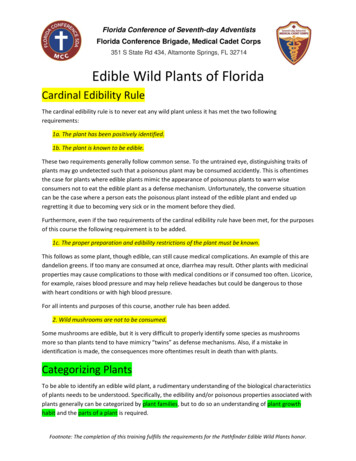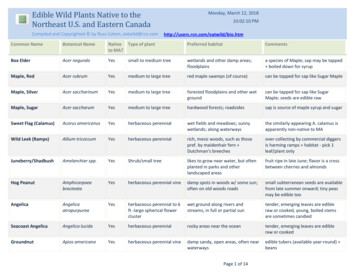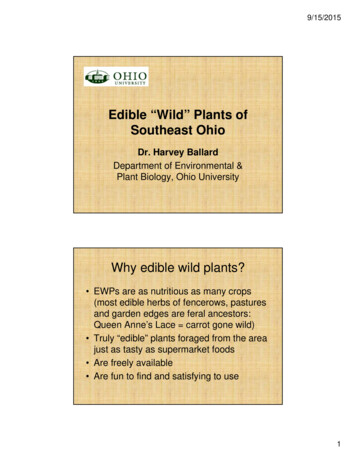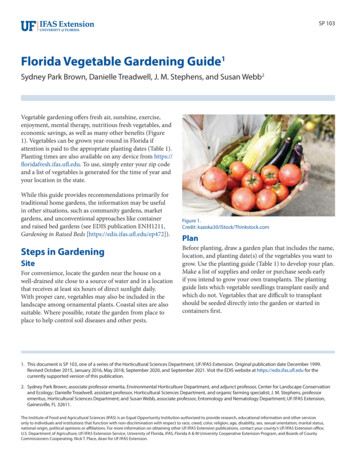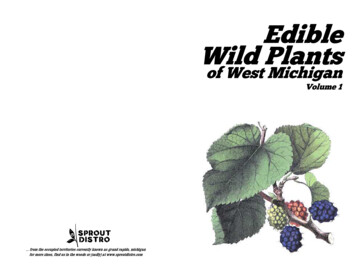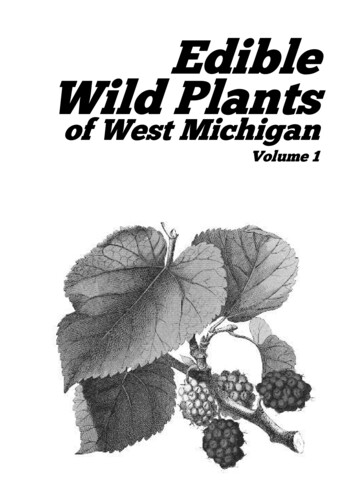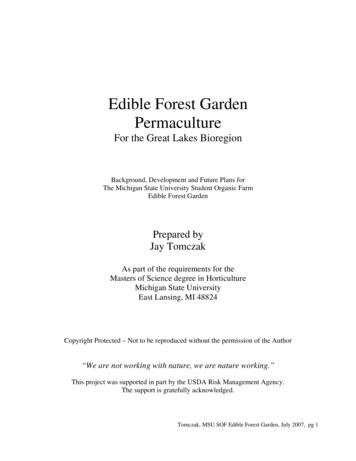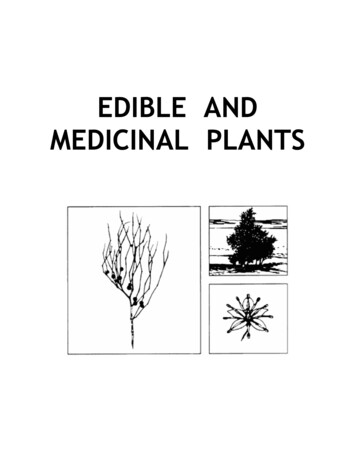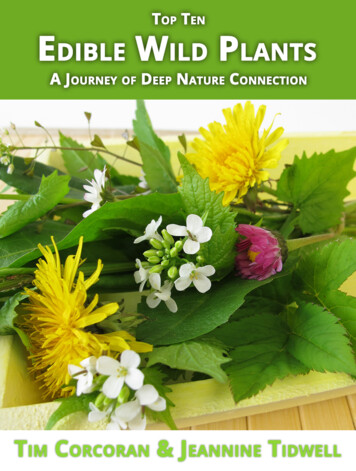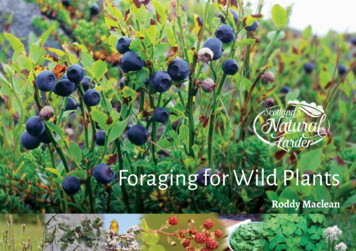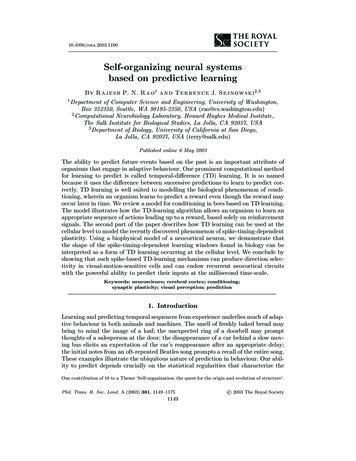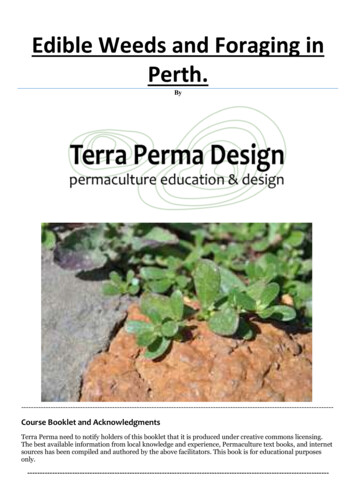
Transcription
Edible Weeds and Foraging -------------------------------------Course Booklet and AcknowledgmentsTerra Perma need to notify holders of this booklet that it is produced under creative commons licensing.The best available information from local knowledge and experience, Permaculture text books, and internetsources has been compiled and authored by the above facilitators. This book is for educational ----------------------------------
Edible Weeds and Foragingby Terra Perma DesignWeed is a term humans have 'made up' for a plant that is growing where we(humans) would prefer it didn't grow.Nature does not have weeds (it does not do weeding). Weeds are natures pioneers they are deliberatelyprolific, opportunistic, vigorous and short life cycledcycled. To do them justice permies call weeds Pioneer plants(and dynamic accumaltors). Theyy are the first plant species to move into a damaged area of soil to 'fix' it formore complicated, sensitive plants and eventual succession to forests.Shallow mat rooted weeds are for bare soil stabilization and shading bear ground. They stop the top soilblowing or washing away and allowlow time for deep rooted weeds and other dynamic accumulators to bringup minerals and trace elements deficient in the top soil (initial germination and growing zone). Once a fewgenerations of weeds have grown, seeded, died, composted and provided habitahabitatt for a accumulating littleecosystem, more advanced but sensitive plants can start to germinate.Instead of fighting weeds while you garden its great that you have taken the time to come and learn toidentify them and what they are trying to do. In the lolongng run it is timesaving, rewarding and empowering tolearn their habits, function and which are edible and useful.In the areas of Biodynamics and Permaculture a lot of time is taken and detail literature written to explainthe purpose and uses of 'weeds's' and more general pioneer plant species. This booklet is a 'pocket guide' toidentifying Perth Edible Weeds, so to learn more about the natural purpose and usefulness of weeds Iadvise further reading or courses in those areas.While this booklet is on edible weeds for Perth Western Australia, most weeds are not native and invasive,so there is a good chance our weeds are your weeds, and so on.Photos of weeds to aid identification are located at the end of this booklet.Most people are shocked at the things I try when I am asked if it’s edible, but I have done lots of researchprior to putting it in my mouth. Truth is most weeds are edible. The reason I will eat it rather than just sayingyes, is, ‘the power of the guinea pig’, people are rightly worried about eating food that may be poisonous.So the purpose of this booklet is to get you looking at, thinking about and ultimately eating or medicinallyusing these readily available, mineral rich, plants. We should all be interested in nutrient dense food withlow food miles that is 'farmed' sustainably ? I assure you there is nothing better in this regard than weeds.As with many things before heading out and eating weeds, Feed the mind, before the mouth, always doyour research and know exactly what family and variety of weed you are chomping!!1Creative Commons – CC-BY-SA1
Edible Weeds and Foragingby Terra Perma DesignI highly recommend getting a 35 copy of, Western Weeds – A Guide to weeds of WA(http://www.wswa.org.au/pps publications.htmhttp://www.wswa.org.au/pps publications.htm),), as a weed guide that has every 'weed' in WA at the time ofpublishing. Unfortunately it doesn’t tell you which are edible but it's clear photographic identification andbotanical names allow you to identify the plants you have. Once you know what it is, searching its edibilityand medicinal uses is both easy and truly astounding. The internet has much on edible weeds, not all of itis correct, so as per all research cross reference and make sure a few people araree advising it as edible.A great place to start once you have the botanical name is Plants for a Future - It has a huge referenceddatabase on all things edible and medicinal and those that are not worth it. - http://www.pfaf.orgThere is far more information on each plant than I can fit in this booklet take the time to look upeach plants detailed edible and medicinal uses, you will be amazed !Other than this booklet and PFAF there is plenty of great info and especially photos on the internet,intern search"edible weeds .au". A few books you could look for are; Doris Pozi's - Edible Weeds and Garden Plants ofMelbourne, The Weed Forager’s Handbook: A Guide to Edible and Medicinal Weeds in Australia by AdamGrubb and Annie Raser-Rowland,Rowland, Wild Food A.B and J.W CRIB, and by the same authors Wild Medicine(good info on natives and weeds, very few pictures).Wild Food Plants by Tim Low and SelfSelf-SufficiencySufficiency and Survival Foods by Isabell Shipard. Useful BushPlants by Peter Bindon is a great indigenindigenousous food and medicine plant guide for Australia.The websites, tweed.com/edible-weeds/weeds/ and .com.au/edibleweeds/facts/ are both excellent Australian sites with reliable information and blogs. There is an amazingarticle on 100 plus edible flowers.Bushcare groups and Farmer Weed identification websites and galleries are excellent, this is a good localresource http://www.bushlandperth.org.au and NZ site //www.terrain.net.nz/friendsgroup/weeds/ has an excellentcellent list of weeds with edibility information.There is also a collaborative google Public Fruit Trees in Perth map here:https://maps.google.com/maps/ms?msid 206354188419166343422.00049b37e6cc15ff4446f&msa 0 Thisis a collaborative work, please respectect others work and personal favorites and only take a little and be sureto add your own discoveries to the map to grow this into a fantastic community resource with everyone'shelp.2Creative Commons – CC-BY-SA2
Edible Weeds and Foragingby Terra Perma DesignThe trick with many leafy edible weeds is to eat the leaves before the plant starts to flower. If you have evertried picking loose leaf lettuce after it starts to flower, in the hope of getting just a few more leaves beforethe plant is inedible, you will know how bitter they can be. It is the same with most weeds, and whilewhil theleaves still have a definite flavour to them, they are more palatable when harvested before anthesis (flowergrowth).Eating weeds is best approached from a ‘super food’ perspective, most are highly mineralized andpowerful plants, eating them alone may not be enjoyable, but, putting a handful of mixed weed greens in asalad greatly increased interest, nutrition and food security. Many of the tougher or strong flavoredweeds/herbs can be used the traditional way of throwing plant material in a pot roroastast or drying to make atea. Currently we are fortunate that we can mix edible and medicinal weeds with normal vegetables tointroduce ourselves gradually and learn the names and flavors along the way.Take this gentle introduction opportunity now as you may find yourself relying solely on weeds later.Eating weeds from public places in a high usage urban area does have some risks. Councils and manyhouse holds use glyphosphate and other chemicals to wage war on these free and hardy plants as theymake path,h, parks and rosebeds untidy. Apply common sense, if a plant looks sick don't eat it, even if ithasn't been sprayed sick looking plants are not healthy food. Also bear in mind that plants like dandelionsare hardy and have a strong root system, they may hhaveave been sprayed multiple times so there could behigher levels of chemical buildup. Though this is not something to stop you foraging be sensible, askquestions of the council or owners, and if you want the plant but are concerned about its toxicity take ithome and plant it in a pot, when it goes to seed or propagates you can then eat those toxin/risk free plants.Another debated concern with consuming weeds is they are often higher in oxalic acids than most commonvegetables. Warrigal greens, oxalis, docdocks,ks, amaranth, fat hen, and purslane are all numerically high. Whilethe body produces its own oxalic acid internally in high food intakes, oxalic acid is considered an antiantinutrient, limiting the absorption of some nutrients, particularly calcium and iroiron.n. I dont tend to worry asweeds are high in all minerals so when oxalic acid comes with calcium and magnesium in the food it is notan issue. Oxalis and Docks, if eaten alone, should be consumed in limited amounts for this reason. If youneed to consumer large quantities you can blanch for 22-33 minutes and discard water some of the mobileacid is removed in the water. Excessive oxalic acid can contribute to kidney stones, gout, and arthritis insome people.As we discussed before treat weeds as a super fofood,od, mix it with kale, root veggies, and other foods and youwont need the consider oxalic acid.Many native bush tuckers and seaweeds etc might have restrictions on their harvesting, many are rare andessential parts of threaten ecosystems. Avoid harvesting native roots (lillys, yams, etc) and killing plantsunless it a matter of your survival. NoNo-oneone will miss introduced weeds and often thank you for removingthem, so while a knowledge of indigenous edibles is essential concentrate your use on commoncomgardenescapes and weeds.Again I caution do take care identifying weeds prior to eating them or using them medicinally. Goodpictures, knowledgeable friends or local groups, and hands on foraging workshops are helpful.When foraging food not in your own backyard ensure the plant has not been sprayed/contaminated. If itlooks sick don’t eat it. If you are not sure what it is don't eat it. Especially important for fungi which Ihave not the experience to cover at this point.3Creative Commons – CC-BY-SA3
Edible Weeds and Foragingby Terra Perma DesignEdible Plants around PerthFor colour pictures of the following plants please refer to you colour photo section.English Dandelion – Taraxacum OfficinaleThe English dandelions are perennial plantplants meaningning leaves will grow back if the taproot is left intact. Whenharvesting just pick individual leaves out of the centre of the crown. Dandelion leaves are generally eatenraw or boiled in salads, the flower petals, along with other ingredients, are used to make dandelion wineand the ground, roasted roots to make dandelion coffee. Transplantlant some to your garden beds as theygrow more lush and palatable.Dandelion leaves contain abundant vitamins and minerals, especially vitamins A,, C and K, and are goodsources of calcium, potassium, iron and manganese.Smooth Cats Ear and Flat Weed – Hypochaeris glabra /radicataThese are the false Dandelions, and while less palatable are still highly nutritious.Though these are very bitter the young leaves, flowers are edible boiled and roots roasted. As withcapeweed excessive consumptionon can cause calcium deficiencies with cattle so go easy, the bitterness willensure that anyway.Hawkbits - Leontodon taraxacoides - As per HypochaerisSow Thistle - Sonchus oleraceusA very common verge and garden weed growing well in poor, sandy, and drdryy soil, it produces yellowflowers, puffy seed-heads,heads, and oozes white sap from broken stems (hence is often incorrectly called milkthistle). Leaves are best harvested before the plant bolts and goes to flower. Mild bitter flavor less so thandandelion or chicory, so great salad greens, if you are pushed for food, the whole plant can be blanched toreduce bitterness.Guilford Grass - Romulea Rosea AustralisSometimes called onion grass, the green plump 1 cm long fruit is a chewy sweet snack. I certainly ateat it bychoice as a child. When they exist in large numbers wait until winter rain then pull them out of the softground, the corms are also edible, they are similar to water chestnuts or could be dried and turned intoflour. Leaves are also apparently edibleble but given the lawnmower cant cut them I shall pass at this point.Sour Sob - Oxalis pes-caprae,caprae, and many othersThe leaves have a tasty sour edge a bit like the sour in sweet and sour sauce, it can therefore make a greatsour sauce.While they are a tastyasty flavor to add to a salad and a good source of Vitamin C, they are also high in oxalicacid so unless blanching and draining water eat in moderation or occasionally. Other Oxalis family, woodsorrel etc are the same.Dock or Sorrel - Garden Sorrel - RuRumex R. Acetosa - Sheep Sorrel - R. Acetosella - Curly Dock - R.CrispusDock leaves have a sour flavour similar to kiwifruit or sour sauce, they may be puréed in soups and saucesor added to salads. The plant's sharp taste is due to oxalic acid, which is a toxin. But docks along withdandelions are the best plants for liver cleansing so take the good with the babad.If you are eating a lot of any Rumex/Sorrel greens cook in water for 33-55 minutes and discard waterdissolving/removing most oxalic acid. Oxalic acid stops calcium adsorption and uses it up, creating kidney4Creative Commons – CC-BY-SA4
Edible Weeds and Foragingby Terra Perma Designstones and other nasty’s, so be aware of this iissue.Mustard , Rocket, and CressCommon garden edibles, but covered here as they are several hardy self seeding members of Brassicafamily whose leaves can add a hot peppery flavour to your dishes. As they self seed prolifically they arecommon in backyards.Back Nightshade - Solanum Nigrum – The ripe berries (black and soft) are edible and very tasty, if youhave ever had gooseberries they taste the same. Note: The green fruits are poisonous. The leaves areeaten like spinach in some African cultures but unless desperate its best to avoid eating all Solanum familyleaves. I eat these berries daily as the weed is prolific, it does not suffer from spider mites like itsmainstream gooseberry counterparts, so its very handy producer in my yard. The berries are medicinallyregarded as a tonic.Plantain - Plantago - Lanceolata and MajorPlantago Major is a great garden green, (but is less a weed than narrow Lanceolata) and while I grow andeat both occasionally I find it’s a better chook and rabbit fodder. LancLanceolataeolata has narrow heavily ribbedleaves that are astringent, and while edible this plant should be consumed in a limited fashion in more of anherbal rather than food sense.Chickweed – Stellaria MediaChickweed common in winter/spring is a tasty nutty edible. Small low growing straggly and delicate weedup to 40cm high with soft lime green smooth ovate shaped leaves. The flowers are white and tiny and occuron downward pointing stalks.It is similar to other inedible weeds, but the key distinguishing feature is a row of fine hairs on the stem thatoccur on one side and swap over to the other side between the leaf nodes.Purslane (Pigweed) - Portulaca oleraceaA ground hugging succulent green/red herb veveryry hardy and invasive when viewed as a weed, but chargeyour perspective this is the easiest growing, mild tasting plant you could grow. Purslane leaves are inOmega-33 fatty acid, and has stems high in vitamin C, also used as a cooling diuretic and blood cleanser.cUse raw in salad, as a pot herb or try add handfuls of purslane sprigs to the juices in the roasting pan, oncehe had removed the roast for carving it is said the greens wilt and the sauce would acquire a sharperflavour and a thicken the sauce.Violetsolets – Viola Sp.More a garden escape, than a weed it is a vigousous soil colonizer with many varieties and flower colours,All flowers are a tasty edible as are the leaves though tasteless.The leaves are also medicinal and have been used for coughs, sosorere throats, and constipation. Note: AfricanViolet is not a true violet and not edible.Clovers White and Red - Tifolium repens and pretenseThis is a wild edible plant everyone knows. The clover leafs are delicious in salads or juices with a bean likeflavour. Clovers are a valuable survival food, as they are high in protein, widespread, and abundant.They are not easy to digest raw, but thithiss can be easily fixed by juicing them. Dried flower heads and seedpods can also be ground up into a nutritious flour and mixed with other foods. Dried flower heads can alsobe steeped in hot water for a healthy, tasty tea.5Creative Commons – CC-BY-SA5
Edible Weeds and Foragingby Terra Perma DesignNut Grass - Oenothera Spp.One off the most cursed word wide weeds, however the small hard nutnut-likelike tubers are edible and eaten rawor cooked. Don’t bother with the rest of the plant parts. They often have a bitter taste, but have excellentnutritional value. It is uncommon here but the yyellowellow nut grass is said to be the best tasting and was a foodsources for native American peoples.Wild/Green Amaranth - Amaranthus powelliiSeveral Amaranth species may be found as garden escapees. Green leaf amaranth as shown below will bemost common. The leaves are best when young, they can be eaten raw, but taste better when steamed orsautéed. You might also find Loves Lies Bleeding has a spectacular red weeping seed head. All types areedible but leaf amaranths are best for leaves.Wild Radish - Raphanus raphanistrumRadish appears in spring en masse and is a forages dream, with an entirely edible offering. Young leaves raw or cooked given a somewhat hot taste in salads or used as a potherb. Use young leaves in spring,older leaves soon become bitter. Seed - raw or cooked has a very pungent flavour, the seed can be groundinto a powder and made into a paste when it is an excellent substitute for mustard. The sproutedsprseedshave a somewhat hot spicy flavour and are a tasty addition to salads. Flowers, white, yellow and sometimespinkish, are eaten raw. The flower buds are used as a broccoli substitute, lightly steamed. Young crisp rawseedpods are great.Evening Primrose - Oenothera biennisCommon evening primrose thrives in Perths sandy soil, and is often seen in flower by the seashore. Theleaves have a peppery bite and can be eaten raw or cooked, though the best, most tender leaves are thoseon the leaf stalk. Someome people may prefer them cooked since they're a bit coarse in texture when raw. Thewhite taproot (often tinged pink at the top) can exceed a foot in length and is, if anything, slightly moreassertive than most radishes. The buds are best cooked, but ththee flowers are best raw. It also has a myriadof medicinal uses, so go find it!Prickly Lettuce – Lactuca Serriola - Called Wild Lettuce, or Prickly lettuce due to its impressive shark teethspikes on leaf undersides and stems, this plant was one of those that the current lettuces where breedfrom.They are common everywhere around Perth in similar areas to Sow Thistle (discussed in earlier editions ofenews), especially roadsides, paved areas and urban zones.The young leaves are an excellent vegetable, raw or cooked. Older leaves are coarse, spiky and very bitter.Three Cornered Garlic - Allium triquetrumThree-corneredcornered leek, or onion weed, is a Mediterranean plant in the family Alliaceae, but can also be foundanywhere wet enough and shaded. Many parts of the plant are edible and taste like garlic or onion. Theplant spreads rapidly and is locally common/incommon/invasive,vasive, particularly in disturbed areas. The bulbs are obviouson the surface of the ground now as small white round single clove bulbs.It is similar to poisonous bulbs but is easily distinguished when you crush the leaves to experience thepungent garlic odour. Don’t collect loose bulbs on the surface in summer unless you are sure of the locationof the winter plants.6Creative Commons – CC-BY-SA6
Edible Weeds and Foragingby Terra Perma DesignMallow – Cheese Wheel Plant - Malva parvifloraMallows are mostly a stewing green as the leaves are a little fuzzy and mucilaginous. Mallows are a goodweed to start foraging as all types are edible and commonly found. Its a great starter is because there areno poisonous look-alikes,alikes, and it tastes good, without the mild bitterness typically found in many of theavailable wild greens.The mucilaginous quality of the mallow leaves acts as a natural thickener for the lasagna.Fat Hen – Lambs Quarters - Goosefoot – Old King Henry - Chenopodium albumTo most people a weed, to me a very useful hardy annual edible leafy garden plant. A large annual withedible leaves, summer shade, next seasons pea/bean poles, and seeds for the cooks if you let them go toseed. Easily control its weedyness by cutting out prior to seed set.Cape Gooseberry – Physalis peruvianaSmall lantern fruit pods with edibleble yellow/orange tangy fruit (eat ripe ones not green), this is not a weed,but is frequently self seeding up as the numerous tiny seed is carried by birds and deposited everywhere.Flax (Linseed) - Linum usitatissimumNormally self seeding in areas when previously grown, you might find flax in your garden, and if not go tothe whole food shops and plant some. Flax seed is edible and very good for you and the plant is easy togrow. It’s also great wood oil.Fennel - Foeniculum vulgareA garden escape, the weedy ones don’t have a swollen bulb like the store ones, but grow easily and tastesimilar. It also produces lots of seed that is worth foraging for an aromatic anise flavored spice. Also a greatpredator bug feeder in the garden.Nasturtium - Tropaeolum majusAll parts of Nasturtiums are edible. The flower has most often been consumed, making for an especiallyornamental salad ingredient; it has a slightly peppery taste reminiscent of watercress,watercress and is also used instir fry. The flowers contain about the same amount Vit C as parsley. The unripe seedsee pods can beharvested and dropped into spiced vinegar to produce a condiment and garnish, sometimes used in placeof capers.An essential garden plant it is also a winter living mulch, pest ttraprap crop and beneficial insect attractantChicory – Cichorium intybusWild chicory leaves are edible but bitter. By cooking and discarding the water the bitterness is reduced,after which the chicory leaves may be sauteed with garlic, anchovies and other ingredients. The morecultivated varieties self seed also so it’s a great plant to grow or forageforage.Nettle – Urtica dioica (perennialrennial roots) and Urtica urens(annual)This plant has stingers, hairs of most nettle species contain formic acid, serotonin and histamine. Cookingwill render the stings, and make a very healthy edible green, pot herb, tea or any other use.7Creative Commons – CC-BY-SA7
Edible Weeds and Foragingby Terra Perma DesignNettle leaves are extremely high in nutrients, so harvest wiwithth gloves, cook and enjoy.Sculpit (Strilotto)- Silene inflate (Sculpit), vulgaris (Bladder Campion)Sculpit or Stridolo is a fast-growing,growing, mildmild-manneredmannered annual blending complex flavors of Chicory, Arugula,Tarragon and other favorite greens.It's leaves are mild with a flavor all its own. Little known outside of Italy, Bladder Champion is often a gardenescape and can be eaten the same when young.Poppy – Papaver hybridium, P. rhoeas, P. somniferumPoppies have edible seeds, much tastier cooked. SomniferSomniferumum while not allowed to be grown as it is theopium poppy is commonly found in gardens and is the commercial variety that provides the small blackpoppy seedsStinking Roger – Tagetes MinutaWhile not edible out of hand, the dryed leaves are made into a tea that has many beneficial properties. Theplant is also a beneficial garden companion and mulch/compost filler.Madeira vine - Anredera cordifoliaMadeira vine is an edible weed similar to ceylon spinach but with a smaller edible leaves and undergroundedible rhizomes (aerial tubers are not edible). It is a very vigorous weedy climbing vine and providescopious amounts of food if utilized.Warringal Greens (NZ Spinach)- Tetragonia tetragonioidesWarrigal greens or New Zealand spinach is a sprawling groungroundd cover type plant which can as the namesuggests be a spinach substitute, it needs to be blanched before eating to remove the oxalic acid which istoxic.Pigface – Carpobrotus (C. aequilaterus, C. edulis, C. virescens)More a coastal native than a weed, Pig face Leaves can be blanched and put in a light pickling solution.The flowers contain a sweet nectar which can be eaten. The fruits are good eating, among Australia'stastiest wild fruits. They turn purple when ripe around Christmas time, and the fleshyflesh pulp can be squeezedout and eaten. The Bright lolly Pink flower is the aequilaterus, yellow flower is a natralised South Africanvariety edulis, and the native virescens all are edible.Brazillian Pepper Tree - Schinus terebinthifoliusBrazilian pepper is a sprawling shrub or small tree, reaching a height of 7–1010 m, and often grouping inthickets. Although it is not a true pepper ((Piper),), its dried drupes are often sold as pink peppercorns, as arethe fruits from the related species Schinus molle (Peruvian peppertree).The seeds can be used as a spice, adding a pepper-like tastete to food. They are usually sold in a dry stateand have a bright pink color. They are less often sold pickled in brine, where they have a dull, almost greenhue.Epazote - Similar to lambs Quarters (fat hen) this plant is easily recognised b y it pungent turpentine/pinesmell. The plant is covered in resin glands which dont disolve in water so add leaves to food or tea anddispose of leaves (and resin/toxin). This is a great wild seasoning herb for mexican dishes, chilli and bean8Creative Commons – CC-BY-SA8
Edible Weeds and Foragingby Terra Perma Designtypes and it reduces wind in beans.Storksbill - Erodium- E. cicutarium, botrys, ccygnorum, also known as Pinweed is an herbaceous annual,and in warm climates a biennial member of the Geranium Family. The entire plant is edible with a flavorsimilar to sharp parsley if picked young. Young leaves - raw or cooked as a potherb. Harvested in thespring before the plant flowers, they are tasty and nutritious. The leaves are added to salads, sandwiches,soups etc, they can be used in recipes that ccallall for leaves of beet, plantain, sow thistle or amaranth. Youngstems - raw. Root - chewed by children as a gum.Bullrushes - TyphaSo commonly eaten wikapedia states " Typha has a wide variety of parts that are edible to humans. Therhizomes,, underground lateral stems, are a nutritious and energyenergy-richrich food source. The content of protein iscomparable to the one of maize or rice. These are starchy, but also fibrous, so the starch must be scrapedscror sucked from the tough fibers. Note if the plants grow in polluted water the rhizomes can accumulate leador residues of pesticides and should not be eaten.The outer portion of young plants can be peeled and the heart can be eaten raw or boiled and eaten likeasparagus. The bases of the leaves can be eaten raw or cooked, in late spring when they are young andtender. In early summer the sheath can be removed from the developing green flower spike which can thenbe boiled and eaten like corn on the cob. In midmid-summer,summer, once the male flowers are mature, the pollen canbe collected and used as a flour supplement or thickener.Fleabanes - Conyza canadensisEdible leaves if cooked but not really worth it. More a medicinal PFAF states C. canadensis - valued mostfor its astringency, being used in the treatment of gastrogastro-intestinalintestinal problems such as diarrhoea anddysentery. It is said to be a very effective treatment for bleeding haemorrhoids. The whole plant isantirheumatic, astringent, balsamic, diuretic, emmenagogue, styptic, tonic and vermifuge.Cobblers Pegs - Bidens pilosaNot that common in Perth but a dominant species in east coascoast,t, Cobblers pegs is a source of food ormedicine. The tender shoots and young leaves are used fresh or dried as a leaf vegetable, particularly intimes of scarcity. The leaves are bitter to taste and not very palatable, but it is still widely eaten in AfricaAfri asa pot herb. It can be used in small amounts in cooked foods, with the bitterness being disguised by otherfoods. The plant's only real virtue is that it is so plentiful.The plant is an accumulator of many minerals including cadmium. In fact, it can be specifically used toremove cadmium from contaminated soils. Cadmium is a common contaminant of soluble phosphatefertilisers and it remains in the soil for up to 1000 years. It is a good idea not to harvest cobblers pegs fromsoils with a history of heavyeavy phosphate fertilising or from industrial or roadside locations where they mayhave been contaminated.Goosegrass, Cleavers - Galium aparineAnother plant not that common in Perth hence not including in the colour slides but common species in eastcoast.t. It is however a very handy plant and worth acquiring, all parts of Galium aparine are edible andalthough the sharp hooks make it not very appealing raw, cooking softens them up so that they no longercause cuts. The youngest shoots are the least bitterbitter.The seeds make a reasonable coffee substitute when dried for a week, then roasted in a hot oven for 59Creative Commons – CC-BY-SA9
Edible Weeds and Foragingby Terra Perma Designminutes, ground and steeped in boiling water as you would for ground coffee beans.The leaves can also be dried and infused into a tea. Use 1 oz (28 grams) per pint (470mL) of boiling water.The number of medicinal uses attributed to the tea of this plant is almost as long as its list of commonnames and it is highly valued by many herbalists.The roots of Galium aparine have been used to make a permanpermanentent red dye which has been used to colourcheeses. The stems of the plants can be rou
"edible weeds .au". A few books you could look for are; Doris Pozi's Melbourne, The Weed Forager’s Handbook: A Guide to Edible and Medicinal Weeds in Australia Grubb and Annie Raser-Rowland, Wild (good info on natives and weeds, very few pictures). Wild Food Plants by T
